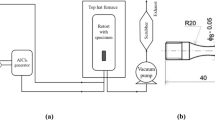Abstract
Modification of pack aluminizing for heat-resistant stainless steels was studied to improve corrosion resistance by controlling the microstructure of the coating layer. The major process parameters examined include the pack powder composition, coating time, and temperature. Depending on the combination of these parameters, the microstructure of the coating layer can be controlled to form either a continuous layer of internal-diffusion barrier (IDB) or an interdiffusion zone (IZ). At the coating-process temperatures, the IDB forms as a mixture of σ- and β-aluminide, whereas the IZ forms as a mixture of α-ferrite and β-aluminide. But the σ phase shown in the IZ at room temperature is formed by transformation from the α phase during cooling. Even though the hardness of the IDB is higher than the other phases present in the coating layer, the aluminide coating layer with the IDB shows outstanding cyclic high-temperature corrosion resistance. As long as the stable IDB forms, the corrosion resistance increases with the thickness of the aluminide-coating layer.
Similar content being viewed by others
References
D. M. Miller, S. C. Kung, S. D. Scarberry, and R. A. Rapp,Oxid. Met. 29, 239 (1988).
N. V. Bangaru and R. C. Krutenat,J. Vac. Sci. Technol. B 2, 806 (1984).
S. C. Kung and R. A. Rapp,J. Electrochem. Soc. 135, 731 (1988).
B. G. Seong, J. H. Song, S. Y. Hwang, and K. Y. Kim, inHigh Temperature Corrosion of Advanced Materials and Protective Coatings, Y. Saito, B. Onay, and T. Maruyama, eds. (Elsevier, North-Holland, 1992).
E. Fitzer and H. J. Maurer, inMaterials and Coatings to Resist High Temperature Corrosion (Applied Science, London, 1978), p. 253.
E. Godlewska and K. Godlewski,Oxid. Met. 22, 117 (1984).
N. V. Bangaru and R. C. Krutenat, NATO ASI Ser. E, Appl. Sci. No. 85 (1984), p. 427.
E. Lang (Ed),The Role of Active Elements in the Oxidation Behavior of High Temperature Metals and Alloys (Elsevier, London, 1989).
W. E. King (Ed),The Active Element Effect on High Temperature Oxidation—After Fifty Years, Materials Science Forum, vol. 43 (Trans. Tech., Switzerland, 1989).
U.S. Patent No. 4,835,010 (1989).
C. J. Novak, inHandbook of Stainless Steels, D. Peckner and I. M. Bernstein, eds. (McGraw-Hill, New York, 1977), p. 4–56.
L. P. Myers, inRef., p. 11–5.
E. Snape, inRef., p. 12–4.
G. W. Goward, D. H. Boone, and C. G. Giggins,Trans. Am. Soc. Met. 60, 228 (1967).
R. Gibson, inRef., p. 8–2.
Author information
Authors and Affiliations
Rights and permissions
About this article
Cite this article
Kim, K.Y., Jung, H.G., Seong, B.G. et al. Improvement of cyclic high-temperature corrosion resistance of pack-aluminized heat-resistant stainless steels. Oxid Met 41, 11–35 (1994). https://doi.org/10.1007/BF01196641
Received:
Revised:
Issue Date:
DOI: https://doi.org/10.1007/BF01196641




